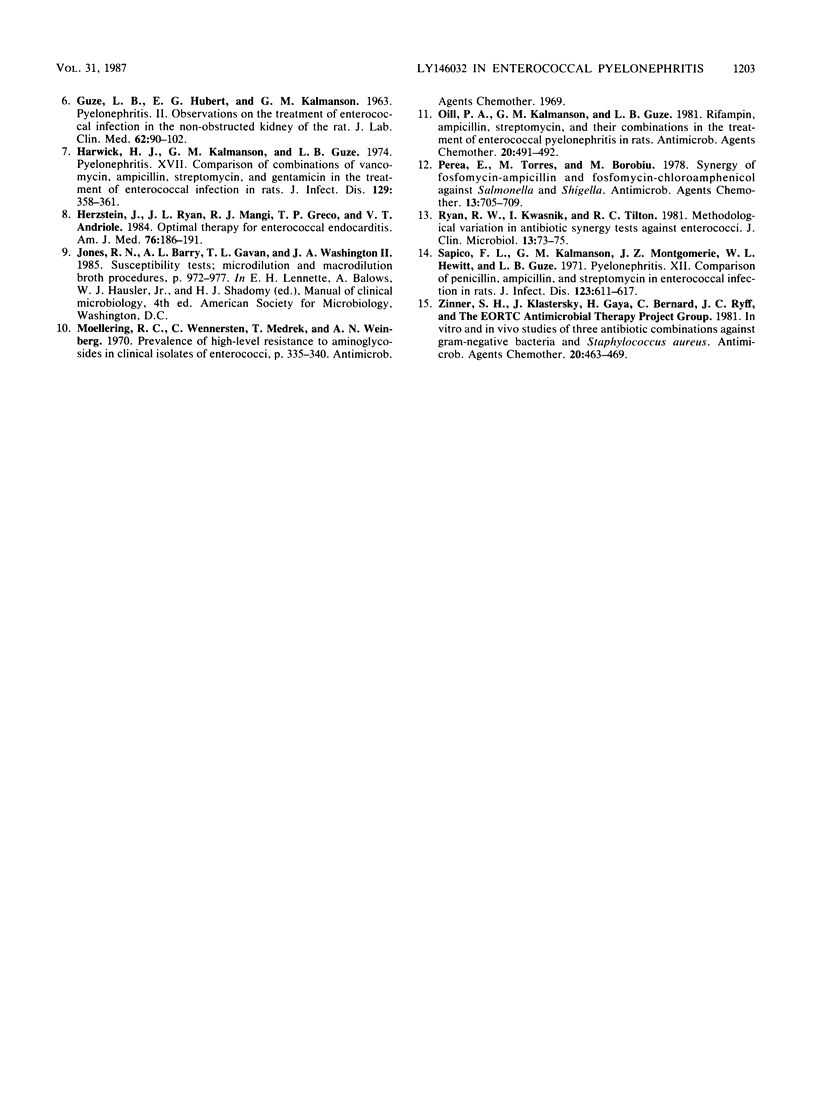Abstract
The efficacy of LY146032 (LY), a new lipopeptide antibiotic, was compared with that of vancomycin, ciprofloxacin, ceftriaxone, imipenem, and gentamicin and combinations of LY-ceftriaxone, LY-imipenem, and LY-gentamicin against 15 strains of Streptococcus (Enterococcus) faecalis by microtiter dilution and checkerboard techniques. LY was effective within a very narrow range of drug concentrations (from 0.125 to 2.0 micrograms/ml) and was more active than other agents tested against S. faecalis. Enhanced inhibition of S. faecalis was seen more frequently with combinations of either penicillin or ampicillin and an aminoglycoside than with combinations of LY and gentamicin, imipenem, or ceftriaxone. The in vivo efficacy of LY was compared with that of vancomycin and ampicillin alone and combinations of vancomycin-gentamicin, ampicillin-gentamicin, and LY-gentamicin in a rat model of chronic enterococcal pyelonephritis. At a dose of 10 mg/kg given twice daily, LY reduced the number of organisms per kidney significantly compared with that in infected untreated controls within 48 h after the initiation of therapy. At 20 mg/kg given once a day, LY was less effective but reduced colony counts significantly after 4 days of therapy, and its activity was comparable to that of vancomycin or vancomycin-gentamicin given twice daily. LY may be a promising agent for the treatment of enterococcal infections.
Full text
PDF




Selected References
These references are in PubMed. This may not be the complete list of references from this article.
- Andriole V. T. Effect of water diuresis on chronic pyelonephritis. J Lab Clin Med. 1968 Jul;72(1):1–16. [PubMed] [Google Scholar]
- Berenbaum M. C. A method for testing for synergy with any number of agents. J Infect Dis. 1978 Feb;137(2):122–130. doi: 10.1093/infdis/137.2.122. [DOI] [PubMed] [Google Scholar]
- Eliopoulos G. M., Willey S., Reiszner E., Spitzer P. G., Caputo G., Moellering R. C., Jr In vitro and in vivo activity of LY 146032, a new cyclic lipopeptide antibiotic. Antimicrob Agents Chemother. 1986 Oct;30(4):532–535. doi: 10.1128/aac.30.4.532. [DOI] [PMC free article] [PubMed] [Google Scholar]
- GUZE L. B., GOLDNER B. H., KALMANSON G. M. Pyelonephritis. I. Observations on the course of chronic non-obstructed enterococcal infection in the kidnev of the rat. Yale J Biol Med. 1961 Apr;33:372–385. [PMC free article] [PubMed] [Google Scholar]
- GUZE L. B., HUBERT E. G., KALMANSON G. M. Pyelonephritis. II. Observations on the treatment of enterococcal infection in the nonobstructed kidney of the rat. J Lab Clin Med. 1963 Jul;62:90–102. [PubMed] [Google Scholar]
- Harwick H. J., Kalmanson G. M., Guze L. B. Pyelonephritis. XVII. Comparison of combinations of vancomycin, ampicillin, streptomycin, and gentamicin in the treatment of enterococcal infection in rats. J Infect Dis. 1974 Mar;129(3):358–361. doi: 10.1093/infdis/129.3.358. [DOI] [PubMed] [Google Scholar]
- Herzstein J., Ryan J. L., Mangi R. J., Greco T. P., Andriole V. T. Optimal therapy for enterococcal endocarditis. Am J Med. 1984 Feb;76(2):186–191. doi: 10.1016/0002-9343(84)90772-1. [DOI] [PubMed] [Google Scholar]
- Moellering R. C., Jr, Wennersten C., Medrek T., Weinberg A. N. Prevalence of high-level resistance to aminoglycosides in clinical isolates of enterococci. Antimicrob Agents Chemother (Bethesda) 1970;10:335–340. [PubMed] [Google Scholar]
- Oill P. A., Kalmanson G. M., Guze L. B. Rifampin, ampicillin, streptomycin, and their combinations in the treatment of enterococcal pyelonephritis in rats. Antimicrob Agents Chemother. 1981 Oct;20(4):491–492. doi: 10.1128/aac.20.4.491. [DOI] [PMC free article] [PubMed] [Google Scholar]
- Perea E. J., Torres M. A., Borobio M. V. Synergism of fosfomycin-ampicillin and fosfomycin-chloramphenicol against Salmonella and Shigella. Antimicrob Agents Chemother. 1978 May;13(5):705–709. doi: 10.1128/aac.13.5.705. [DOI] [PMC free article] [PubMed] [Google Scholar]
- Ryan R. W., Kwasnik I., Tilton R. C. Methodological variation in antibiotic synergy tests against enterococci. J Clin Microbiol. 1981 Jan;13(1):73–75. doi: 10.1128/jcm.13.1.73-75.1981. [DOI] [PMC free article] [PubMed] [Google Scholar]
- Sapico F. L., Kalmanson G. M., Montgomerie J. Z., Hewitt W. L., Guze L. B. Pyelonephritis. XII. Comparison of penicillin, ampicillin, and streptomycin in enterococcal infection in rats. J Infect Dis. 1971 Jun;123(6):611–617. doi: 10.1093/infdis/123.6.611. [DOI] [PubMed] [Google Scholar]


